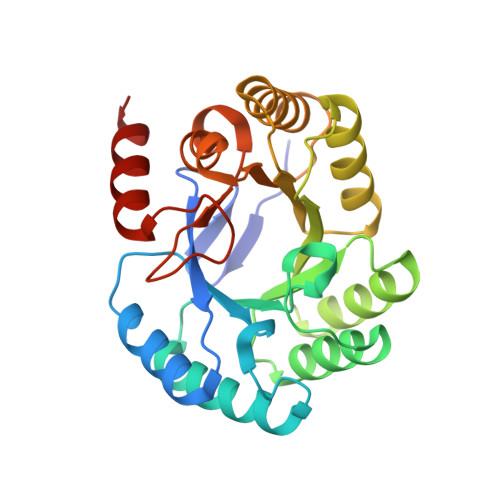Insights into the mechanism of type I dehydroquinate dehydratases from structures of reaction intermediates.
Light, S.H., Minasov, G., Shuvalova, L., Duban, M.E., Caffrey, M., Anderson, W.F., Lavie, A.(2011) J Biol Chem 286: 3531-3539
- PubMed: 21087925
- DOI: https://doi.org/10.1074/jbc.M110.192831
- Primary Citation of Related Structures:
3JS3, 3M7W, 3NNT - PubMed Abstract:
The biosynthetic shikimate pathway consists of seven enzymes that catalyze sequential reactions to generate chorismate, a critical branch point in the synthesis of the aromatic amino acids. The third enzyme in the pathway, dehydroquinate dehydratase (DHQD), catalyzes the dehydration of 3-dehydroquinate to 3-dehydroshikimate. We present three crystal structures of the type I DHQD from the intestinal pathogens Clostridium difficile and Salmonella enterica. Structures of the enzyme with substrate and covalent pre- and post-dehydration reaction intermediates provide snapshots of successive steps along the type I DHQD-catalyzed reaction coordinate. These structures reveal that the position of the substrate within the active site does not appreciably change upon Schiff base formation. The intermediate state structures reveal a reaction state-dependent behavior of His-143 in which the residue adopts a conformation proximal to the site of catalytic dehydration only when the leaving group is present. We speculate that His-143 is likely to assume differing catalytic roles in each of its observed conformations. One conformation of His-143 positions the residue for the formation/hydrolysis of the covalent Schiff base intermediates, whereas the other conformation positions the residue for a role in the catalytic dehydration event. The fact that the shikimate pathway is absent from humans makes the enzymes of the pathway potential targets for the development of non-toxic antimicrobials. The structures and mechanistic insight presented here may inform the design of type I DHQD enzyme inhibitors.
Organizational Affiliation:
Center for Structural Genomics of Infectious Diseases, Feinberg School of Medicine, Northwestern University, Chicago, Illinois 60611, USA.















